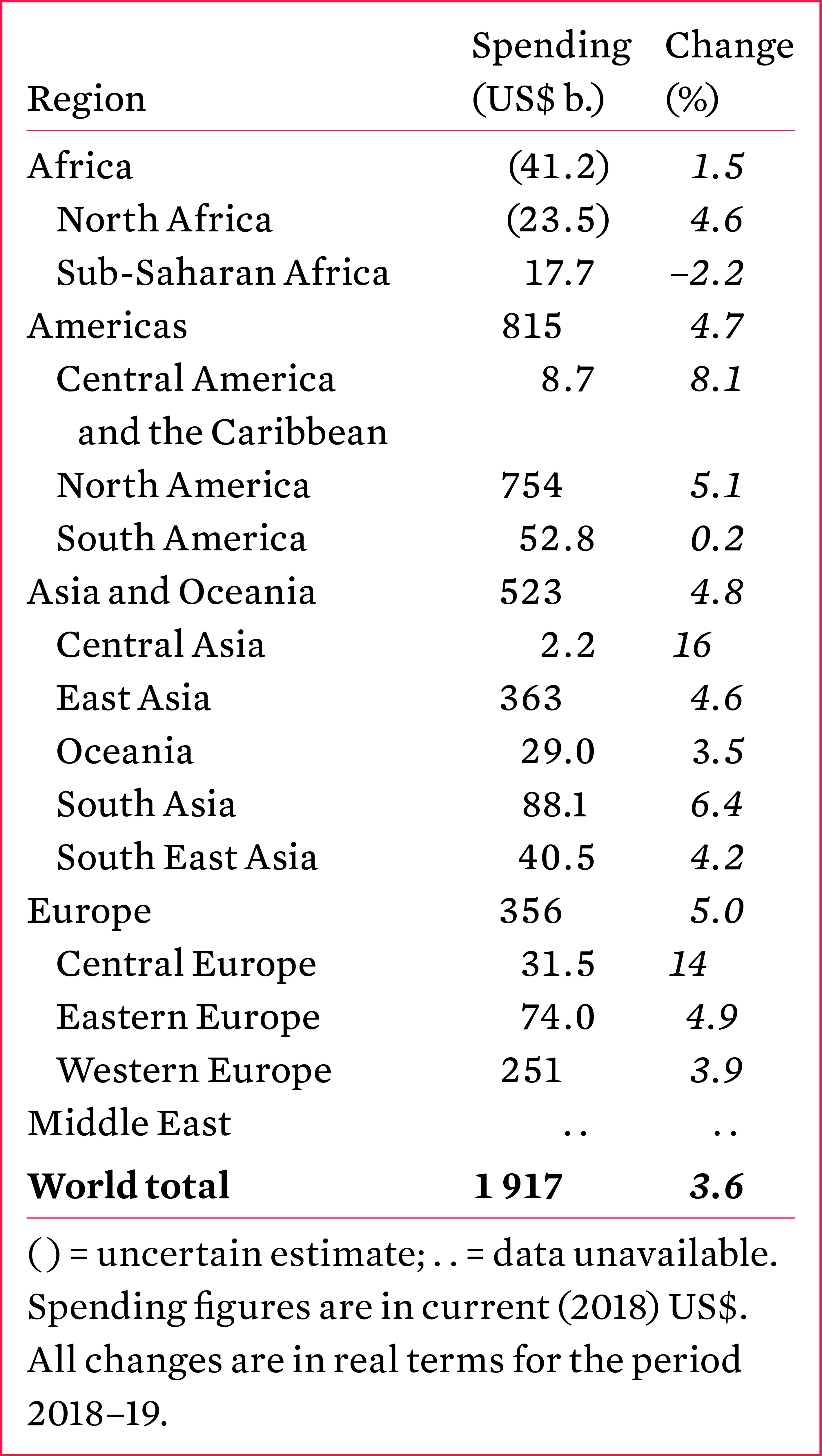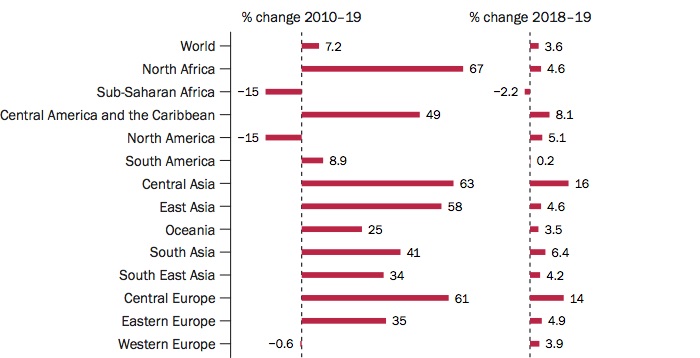8. Military expenditure
Overview, Nan Tian [PDF]
I. Global developments in military expenditure, 2019, Nan Tian, Pieter D. Wezeman, Diego Lopes da Silva, Siemon T. Wezeman and Alexandra Kuimova [PDF]
II. Regional developments in military expenditure, 2019 [PDF]
III. Spending on military equipment by European members of the North Atlantic Treaty Organization, Nan Tian, Diego Lopes da Silva and Pieter D. Wezeman [PDF]
IV. Transparency in military expenditure, Pieter D. Wezeman and Siemon T. Wezeman [PDF]
World military expenditure is estimated to have been US$1917 billion in 2019. It accounted for 2.2 per cent of world gross domestic product (GDP) or $249 per person. Spending in 2019 was 3.6 per cent higher than in 2018 and 7.2 per cent higher than in 2010. The growth in total global military spending in 2019 was the fifth consecutive annual increase and the largest of the decade 2010–19, surpassing the 2.6 per cent rise in 2018. Military expenditure also increased in at least four of the world’s five regions: by 5.0 per cent in Europe, 4.8 per cent in Asia and Oceania, 4.7 per cent in the Americas and 1.5 per cent in Africa. For the fifth successive year, SIPRI cannot provide an estimate of total spending in the Middle East.
The largest military spenders in 2019
The growth in total spending in 2019 was largely influenced by expenditure patterns in the United States and China, which together account for over half of the world’s military spending. The USA increased its spending for the second straight year to reach $732 billion in 2019. This was 2.7 times larger than the $261 billion spent by China, the world’s next highest spender. China’s total was 5.1 per cent higher than in 2018 and 85 per cent higher than in 2010. With a 16 per cent decrease in its spending, Saudi Arabia fell from being the third--largest spender in 2018 to fifth position in 2019. India’s spending of $71.1 billion ranked it as the third-largest spender for the first time, while Russia’s increase of 4.5 per cent moved it up from fifth to fourth.
Among states in Western Europe, France continued to spend the most, with military expenditure of $50.1 billion in 2019. However, the largest increase in spending among the top 15 military spenders in 2019 was made by Germany: its military spending rose by 10 per cent to $49.3 billion.
World military spending, 2019

Regional comparisons
Military expenditure is not evenly distributed among the world’s regions. Total military expenditure in Europe totalled $356 billion in 2019, accounting for 19 per cent of global spending. This was behind spending by states in the Americas, at $815 billion (43 per cent of the world total), and Asia and Oceania, at $523 billion (27 per cent of world spending). Spending in the Middle East is estimated to have been around 9.4 per cent of the world total. The $41.2 billion spent by African countries was the lowest of all the regions, at only 2.1 per cent of global military expenditure.

Military spending by NATO members
In 2014, North Atlantic Treaty Organi-zation (NATO) members pledged to increase their military expenditure as a share of GDP to 2 per cent and to spend at least 20 per cent of their military expenditure on equipment. The number of European NATO countries allocating 20 per cent or more of their military expenditure to equipment increased from 5 in 2014 to 14 in 2019. The five with the highest relative increase in equipment spending as a share of total military expenditure—Bulgaria, Hungary, Lithuania, Romania and Slovakia—are all in Central Europe. While their sharp increases were driven by numerous factors—such as the need to modernize their weaponry or to decrease their dependence on Russia for main-tenance of existing weapon systems—the primary reason was their perception of a heightened threat from Russia. Among other European members of NATO, increases in equipment spending as a share of military expenditure have been more moderate.
Transparency in military expenditure
Tracking countries’ military expenditure requires transparency. However, the rate of reporting to military spending information exchange mechanisms administered by the United Nations and the Organization for Security and Co-operation in Europe continued to decrease in 2019, while reporting to a South American registry seems to have ended entirely.
Transparency varies widely at the national level. In some states, often those ruled by military regimes, military expenditure is funded outside the government budget. The case of Myanmar—highlighted in a 2019 UN report—underscores how off-budget funding mechanisms and opacity in military expenditure can allow the military to act unchecked and to perpetrate crimes against minorities.